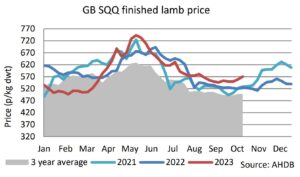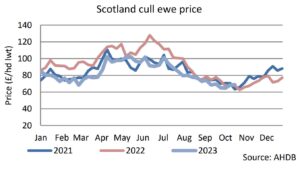Agribusiness News November 2023 – Sheep
1 November 2023Short term outlook
The European Commission have recently published their short-term outlook for 2023-2024. In this it details how the European sheep flock is declining, by an estimated 1.8% in 2023, and a forecasted further decline of 1% in 2024, due to various factors including, high input costs, a low supply and stock of forage following the long, dry, hot summer and losses through outbreaks of disease e.g., Sheep Pox and Blue Tongue.
In the outlook, they cover all aspects of agriculture, showing the predicted trends in the short-term period. It allows a good comparison between proteins, and they show per capita consumption (the yearly use of a particular meat by each person, calculated by dividing the amount used by the population) for each type of meat. It shows that many meats are likely to endure decreases in consumption due to the increased cost of living and inflation. However, lamb, being the most expensive meat, will feel little negative impact due to being favoured as the meat of choice for cultural reasons and religious festivals. Year on year differences in per capita consumption of the various protein meat sources in the EU are forecast as follows:

Chicken is estimated to increase in consumption, due it to being one of the cheapest forms of animal protein as well as an increased supply of poultry due to a lower amount of avian influenza affecting flocks.
EU customers
The EU remains committed to importing UK sheep meat, due to our competitive price and location, which makes the EU outlooks a great tool and good news for Scotland.
The UK lamb price has remained higher than the past two years (2021 and 2022) since August this year. Typically, we see this price continue to increase until the end of the year from now.

However, to remain attractive to our European customers our price must stay competitive, especially when our supply of finished lambs going to slaughter is increasing over the coming months.
Cull trade
While our prime lamb trend is showing higher than previous years, our cull trade is following a very similar pattern to that of 2021 and 2022. With poorer hill ewes making a current impact on average prices at market, well fleshed ewes are very much sought after and making a premium. Supply will run short of these culls as winter progresses, and we will see the market sharpen in coming months, especially for the better quality fleshy types.

Kirsten Williams; 07798617293

Sign up to the FAS newsletter
Receive updates on news, events and publications from Scotland’s Farm Advisory Service

